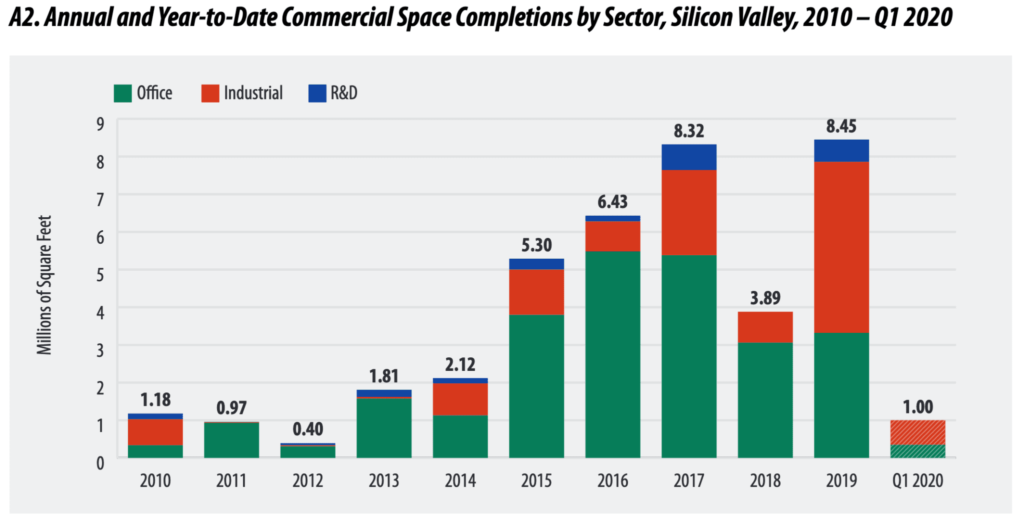The worldwide coronavirus pandemic has been felt in all industries, but one of the most stark representations of the virus’ impact is in the empty office buildings and rolling tech campuses in busy, work-obsessed Silicon Valley.
Ripple effects of staying at home appear in small, nuanced ways in a new report, released by Joint Venture Silicon Valley and commercial real estate brokerage JLL, which analyzes real estate data from the first quarter.
That data capture the effects of only about two weeks of the region’s shelter-in-place order, and show an economically strong Silicon Valley. Vacancy, on average across Silicon Valley, hovered around 11.5 percent while rents increased, venturing above $5.25 per square foot. A near-record amount of development was underway.
“We, the United States, went into this incredibly strong,” Nick Goddard, senior vice president for Colliers International, said in an interview Wednesday. “We’re going to come out of this, where we’ll say ‘that didn’t feel so good,’ but, all of our fundamentals are pretty strong.”


Goddard is feeling particularly hopeful about Silicon Valley and San Jose, which he said is well-positioned to weather the storm with its hometown tech companies that aren’t likely to fold due to the virus.
But there have been negative effects.
Some companies that leased space before the novel coronavirus hit the area still haven’t been able to move into their offices, including Rambus, which is moving its headquarters from Sunnyvale to San Jose. That could drive down “net absorption,” a key real estate indicator of how much space companies are taking up that many consider an economic bellwether.
The report also shows the region is on track to complete less than half of the new commercial development compared to last year.


That could be due in some part to the slowdown caused by the coronavirus, which shuttered Bay Area construction sites starting March 17. But the report notes that the virus and resulting shutdowns will almost certainly exacerbate a slowdown in construction in second quarter.
As of Monday, all construction projects that could implement required safety protocols could resume work — which marks a “turning point” for the industry, Rachel Massaro, vice president and director of research for Joint Venture, said in an interview.
“We’ll have to see what happens now,” she said. “But it would be very surprising if we were to continue to have more and more in-progress space.”
About 86 percent of the nearly 16 million square feet of commercial space under construction last quarter is pre-leased — mostly to major tech companies. That level of commercial construction activity rivals the building boom ahead of the dot-com bust of 2000.
Of that, two of the major projects underway are in San Jose — one 600,000-square-foot development already claimed by Verizon Media near the airport and another equally large development in North San Jose that Google is slated to occupy.


But some real estate insiders say they expect the virus, and resulting office shutdowns, to change the way the region works long after the virus is contained. Leasing has slowed among the largest tech titans in the region, including Facebook, Apple, Amazon, Netflix and Google, according to the report, though many real estate insiders say it is a temporary slump.
“Particularly as more people continue to work from home and we get into that routine, it’s possible that some of our companies will decide that’s the new normal for them and they don’t need quite as much space as they thought,” Massaro said.
But Goddard said he still sees demand for such space, even if working from home becomes more common in the future, particularly as companies account for requirements around social distancing, because that may demand larger offices than before.
But where he sees the biggest potential disruption are in projects that haven’t started yet.
“Just with the way construction is financed, it’s very difficult, once you’ve started, to stop,” Goddard said. “But if you haven’t started, I think it would be a very, very ballsy move to start now. I can’t imagine anyone (starting construction on a new project) in the next six months.”
Contact Janice Bitters at [email protected] or follow @JaniceBitters on Twitter.


